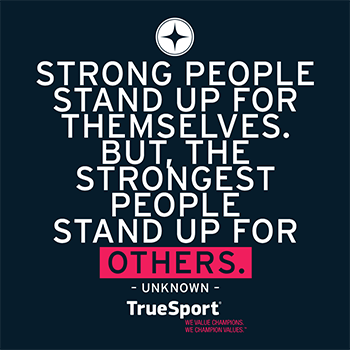
Bullying is not uncommon. In fact, according to StopBullying.gov, more than 70 percent of teens report seeing some kind of bullying in their schools, and 30 percent admit to having taken part in bullying.
BULLYING: intentionally using verbal or physical means to intimidate or harm
More simply put, bullying is intentionally and repeatedly hurting someone emotionally or physically. This includes teasing, spreading rumors or any other action that may cause harm.
When it comes to sports, verbal and physical bullying are equally as common and can occur not only with teammates, but with coaches as well. For this reason, efforts to combat bullying need to involve everyone.
Coaches are one of the biggest influences in athletes’ lives. In many ways, putting a stop to bullying behavior begins and ends with the coach, who can work with athletes to improve the team environment.
These nine tips will help you put a stop to bullying.
- Be an anti-bullying role model. Coaches can be a strong deterrent to bullying if they make it clear they are firmly against it. Relationships with players matter, and athletes who report having a good relationship with their coach are less likely to engage in antisocial behavior such as bullying.
- Encourage players (and each other) to report bullying. Create an environment at the start of the season that does not condone it. Discuss bullying and supervise players’ unstructured time during practices, games and tournaments. <
- Have open discussions. Talking about what is acceptable and unacceptable behavior on and off the court is an important part of reducing bullying.
- Clearly state the punishment for bullying. Be clear about the procedure that will be followed if bullying occurs. Be particularly aware not to inadvertently blame the victim for being bullied.
- Identify the origin of the bullying. Coaches should take the time to identify the sources of bullying to help diminish reactionary behavior, such as retaliating against the bully. Coaches should help the victim find constructive ways to respond to the bully and remind them to always report incidents instead of retaliating.
- Keep your players’ attention. Supervise athletes and provide them with clear goals to help reduce the frequency of negative interactions. Increased supervision during unstructured time is essential to prevent and reduce bullying, as this is the time in which most bullying occurs.
- Protect all athletes equally. Coaches tend to be more vigilant in protecting obvious victims against bullying, but all athletes should be looked after and supported equally.
- Break up cliques. Research shows that strong cliques within teams can lead to strong bullying and antisocial behavior toward other teammates. Emphasize the team as a whole over subgroups to maintain a positive and healthy team dynamic.
- Don’t encourage harmful behavior. Do not teach or condone rude behavior on the court, as it can result in similar behavior off the court. Work to channel anger or frustration into productive actions within the match.
When players and coaches talk about bullying and face it head on, the entire team benefits. It’s important that we all work together to take a stand and win against bullying.
All adults working with USA Volleyball clubs are required to take SafeSport training. We encourage coaches and players to report physical or emotional misconduct, bullying, hazing and/or harassment to USA Volleyball’s SafeSport Program.
Thank you to TrueSport® for providing this content. TrueSport is a grassroots movement born and powered by the experience and values of USADA–the U.S. Anti-Doping Agency. The TrueSport mission is simple and bold: to change the culture of youth sport by providing powerful educational tools to equip young athletes with the resources to build the life skills and core values for lasting success on and off the field. Sport bullying experts Dr. Amy L. Baltzell and Dr. Melissa Holt also contributed to this article.
